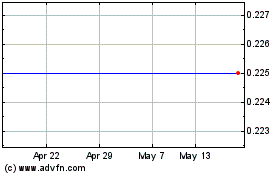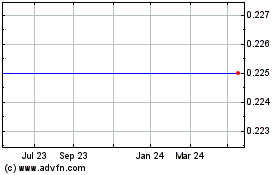Should the forecasts not be achieved or external funding be
inadequate, the Company will be reliant on support from
shareholders to enable it to meet its liabilities as and when they
fall due. The board has held discussions with shareholders
regarding possible future funding requirements.
While no binding commitment has been given by the shareholders
to provide additional funding, the outcome of the discussions was
such that the board is of the opinion that this will be available
as necessary for the coming twelve months and so it is appropriate
to prepare the financial statements on a going concern basis.
Basis of consolidation
(i) Subsidiaries and controlled entities
The consolidated financial statements incorporate the financial
statements of the Company and entities controlled by the Company
(its subsidiaries) made up to 28/29 February each year. Control is
recognised where the Company has the power to govern the financial
and operating policies of an investee entity so as to obtain
benefits from its activities.
The results of subsidiaries and controlled entities acquired or
disposed of during the period are included in the consolidated
income statement from the effective date of acquisition, or up to
the effective date of disposal, as appropriate. Changes in the
Group's interests in subsidiaries and controlled entities that do
not result in a loss of control are accounted for as equity
transactions.
(ii) Associates
Associates are those entities in which the Group has significant
influence, but not control, over the financial and operating
policies. The consolidated financial statements include the Group's
share of total comprehensive income of associates on an equity
accounted basis, from the date that significant influence commences
until the date that significant influence ceases. When the Group's
share of losses exceeds its interest in an associate, the Group's
carrying amount is reduced to nil and recognition of further losses
is discontinued except to the extent that the Group has incurred
legal or constructive obligations or made payments on behalf of an
associate.
(iii) Transactions eliminated on consolidation
Intra-group transactions, balances and unrealised gains on
transactions between Group companies are eliminated. Unrealised
losses are eliminated in the same way as unrealised gains, but only
to the extent that there is no evidence of impairment.
Business combinations
The acquisition of subsidiaries is accounted for using the
acquisition method. The cost of acquisition is measured at the
aggregate of the fair values, at the date of acquisition, of assets
given, liabilities incurred or assumed and equity instruments
issued by the group in exchange for control of the acquiree.
Acquisition related costs are recognised in profit or loss as
incurred.
The assets, liabilities and contingent liabilities of the
acquiree are measured at their fair value at the date of
acquisition. Any excess of the fair value of the consideration paid
over the fair value of the identifiable net assets acquired is
recognised as goodwill. If the fair value of the consideration is
less than the fair value of the identifiable net assets acquired,
the difference is recognised directly in the income statement.
Foreign currency translation
(i) Functional and presentational currency
The individual financial statements of each Group company are
presented in the currency of the primary economic environment in
which it operates ("the functional currency"). The consolidated
financial statements are presented in US Dollars.
(ii) Transactions and balances
Foreign currency transactions are translated into the functional
currency of the entity using the exchange rates prevailing at the
dates of the transactions. Foreign exchange gains and losses
resulting from the settlement of such transactions and from the
translation of monetary assets and liabilities denominated in
foreign currencies at period end exchange rates are recognised in
the income statement.
(iii) Consolidation
For the purpose of presenting consolidated financial statements,
the assets and liabilities of the Group's foreign operations are
translated at exchange rates prevailing at the balance sheet date.
Income and expense items are translated at the average exchange
rates for the period, unless exchange rates fluctuate significantly
during the period, in which case exchange rates at the date of the
transactions are used. Exchange differences arising from the
translation of the net investment in foreign operations are
recognised in the Group's translation reserve, a separate component
of equity, via the Consolidated Statement of Comprehensive Income.
Such translation differences are recognised as income or expense in
the period in which the operation is disposed of.
The following exchange rates have been used in preparing the
consolidated financial statements:
2012:
Average Rate Closing Rate
Rand: USD 7.36 7.53
Sterling: USD 0.63 0.63
Mozambique New Metical: USD 27.92 27.20
2011:
Average Rate Closing Rate
Rand: USD 7.22 6.97
Sterling: USD 0.65 0.62
Mozambique New Metical : USD 33.59 31.10
Revenue recognition
Revenue is recognised when revenue and associated costs can be
measured reliably and future economic benefits are probable.
Revenue is measured at the fair value of the consideration received
or receivable for goods and services provided in the normal course
of business, net of discounts, VAT and other sales related
taxes.
Sales of goods are recognised when goods are delivered and title
has passed. Delivery occurs when the products have arrived at the
specified location, and the risks and rewards of ownership have
been transferred to the customer.
Revenue from services is recognised at the contractual rates as
hours are delivered and materials expenses are incurred.
Interest income is accrued on a time-apportioned basis, by
reference to the principal outstanding and at the effective
interest rate applicable, which is the rate that exactly discounts
estimated future cash receipts through the expected life of the
financial asset to that asset's net carrying amount.
Leasing
Rentals payable under operating leases are charged to income on
a straight-line basis over the term of the relevant lease. Benefits
received and receivable as an incentive to enter into an operating
lease are also spread on a straight line basis over the lease
term.
Taxation
The Company is resident for taxation purposes in the Isle of Man
and its income is subject to Isle of Man income tax, presently at a
rate of zero. The income of overseas subsidiaries will be subject
to tax at the prevailing rate in each jurisdiction.
The income tax expense for the period comprises current and
deferred tax. Income tax is recognised in the income statement
except to the extent that it relates to items recognised in other
comprehensive income or directly in equity. In that case, tax is
also recognised in other comprehensive income or directly in
equity, respectively. Taxable profit differs from accounting profit
as reported in the income statement because it excludes items of
income or expense that are taxable or deductible in other years and
it further excludes items that are never taxable or deductible.
Current tax expense is the expected tax payable on the taxable
income for the year. It is calculated on the basis of the tax laws
and rates enacted or substantively enacted at the balance sheet
date, and including any adjustment to tax payable in respect of
previous years.
Deferred tax is provided using the balance sheet liability
method, providing for temporary differences between the carrying
amounts of assets and liabilities for financial reporting purposes
and the amounts used for taxation purposes. Deferred tax assets are
recognised to the extent that it is probable that taxable profit
will be available against which the asset can be utilised. This
requires judgements to be made in respect of the availability of
future taxable income.
The Group's deferred tax assets and liabilities are calculated
using tax rates that are expected to apply in the period when the
liability is settled or the asset realised based on tax rates that
have been enacted or substantively enacted by the reporting
date.
Deferred income tax assets and liabilities are offset only when
there is a legally enforceable right to offset current tax assets
against current tax liabilities and when the deferred income tax
assets and liabilities relate to income taxes levied by the same
taxation authority on either the same taxable entity or different
taxable entities where there is an intention to settle the balances
on a net basis.
No deferred tax asset or liability is recognised in respect of
temporary differences associated with investments in subsidiaries,
branches and joint ventures where the Group is able to control the
timing of reversal of the temporary differences and it is probable
that the temporary differences will not reverse in the foreseeable
future.
Intangible asset - Goodwill
Goodwill arising on the acquisition of subsidiaries is
recognised as an asset and is separately disclosed.
African Med (LSE:AMEI)
Historical Stock Chart
From Apr 2024 to May 2024

African Med (LSE:AMEI)
Historical Stock Chart
From May 2023 to May 2024
